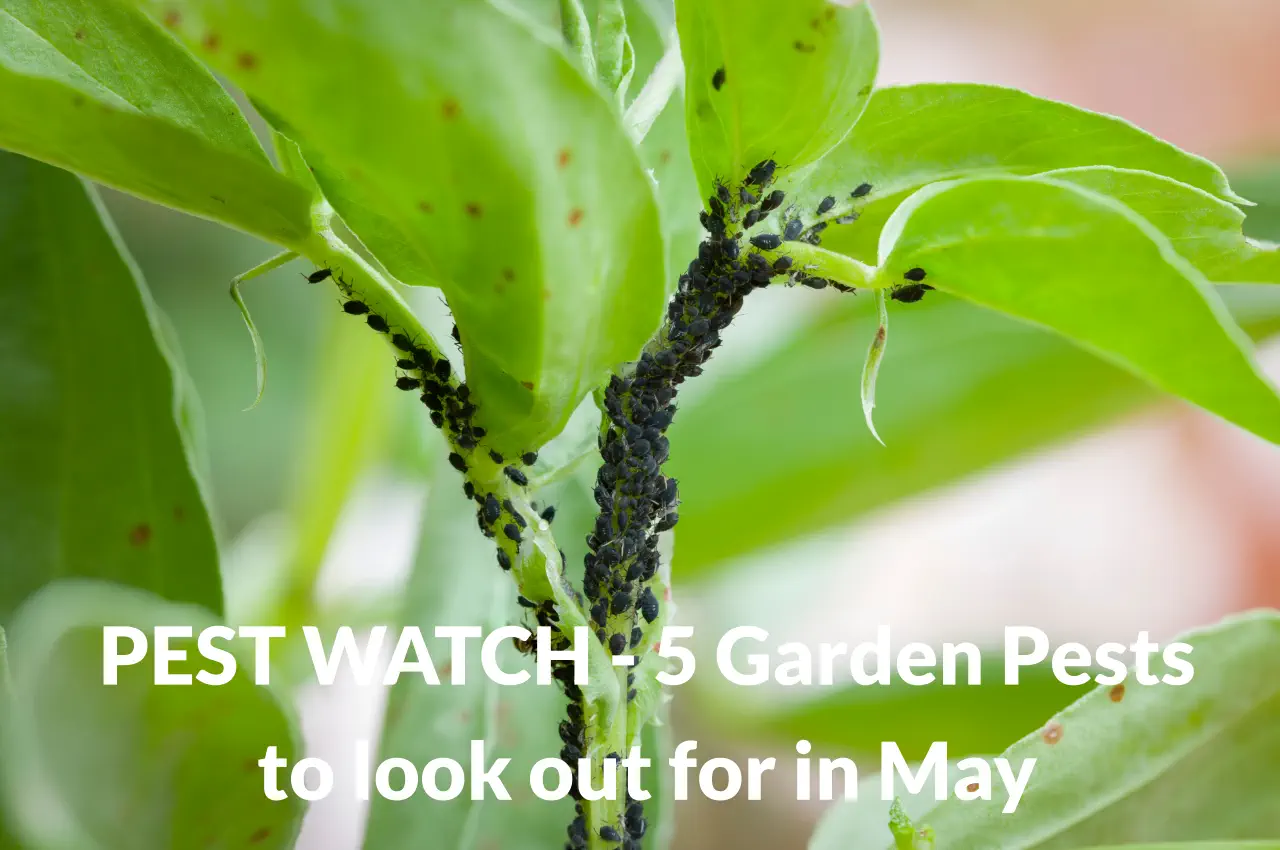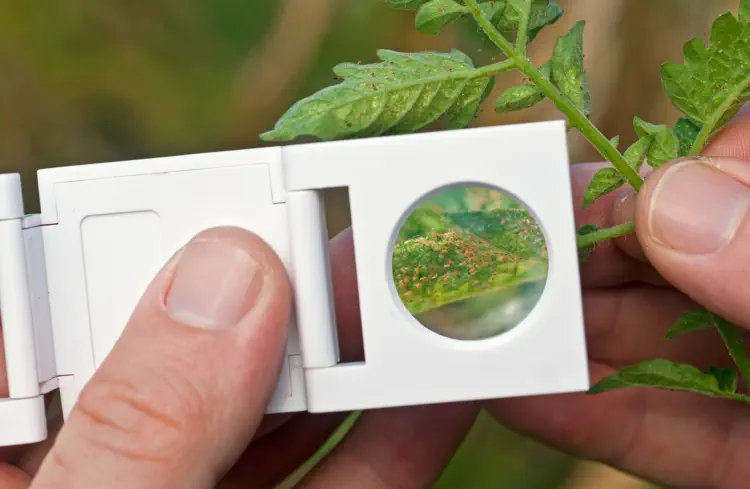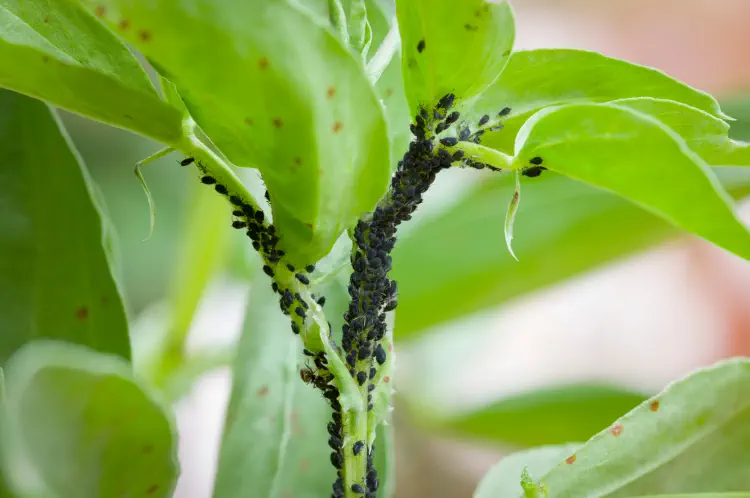Blight can wipe out your crop. Choosing the right blight resistant seed potatoes is crucial for a healthy harvest.
Read on to find out the top varieties of blight resistant seed potatoes that will save your yield....

As spring unfolds and the garden bursts into life, May heralds a time of vibrant growth and abundant blooms. However, amidst the verdant splendor, gardeners must remain vigilant against the resurgence of common pests eager to feast on tender foliage and burgeoning crops.
In this blog, we'll explore five garden pests that pose a threat in May, from voracious insects to opportunistic mammals. By staying informed and proactive, you can safeguard your garden against these intruders and nurture a thriving outdoor oasis throughout the growing season.

Red spider mites, also known as two-spotted spider mites (Tetranychus urticae), are common greenhouse pests that can cause significant damage to a wide range of plants. Here's a more detailed expansion on red spider mites and how to manage them:
Description: Red spider mites are tiny arachnids, not insects, measuring only about 0.5 millimeters in length. They are usually reddish-brown in color, although they may appear greenish or yellowish depending on their diet and environmental conditions. Despite their small size, red spider mites can multiply rapidly under favorable conditions.
Feeding Behavior: Red spider mites feed by piercing plant cells with their mouthparts and sucking out the contents, including chlorophyll. This feeding damage results in characteristic stippling or tiny yellow dots on the upper surface of leaves, which may eventually turn bronze or yellow and drop prematurely. In severe infestations, leaves may become desiccated and defoliation can occur.
Lifecycle: Red spider mites thrive in warm, dry environments, making greenhouses particularly conducive to their proliferation. Their life cycle typically consists of egg, nymph, and adult stages. Under optimal conditions, red spider mites can complete a generation in as little as one to two weeks, leading to rapid population growth.
Damage: Red spider mite infestations can weaken plants and reduce their vigor, making them more susceptible to other stresses such as drought and disease. Severe infestations can cause significant economic losses in commercial greenhouse crops. In addition to direct feeding damage, red spider mites can also produce webbing on plants, which can further interfere with photosynthesis and plant health.
Control: Managing red spider mites in the greenhouse requires an integrated approach that combines cultural, mechanical, biological, and chemical control methods:
Increase humidity: Red spider mites thrive in dry conditions, so increasing humidity levels in the greenhouse can help deter their spread. Use misting systems, humidifiers, or simply dampening the floor to raise humidity levels.
Biological control: Introducing natural predators such as predatory mites (e.g., Phytoseiulus persimilis) or predatory insects (e.g., predatory thrips) can help keep red spider mite populations in check. These beneficial organisms feed on red spider mites and can provide effective, long-term control.
Cultural control: Practicing good greenhouse sanitation, including removing plant debris and weeds, can help reduce red spider mite habitat and breeding sites. Avoid over-fertilization, which can stimulate rapid plant growth and make plants more attractive to mites.
Mechanical control: Regularly inspect plants for signs of red spider mite infestation and remove affected leaves or plants to prevent the spread of mites. Additionally, washing plants with a strong jet of water can help dislodge mites and reduce their numbers.
Chemical control: In severe infestations, chemical pesticides may be necessary to control red spider mites. However, repeated use of pesticides can lead to the development of resistance and harm beneficial organisms. If using pesticides, choose products that are specifically labeled for red spider mite control and follow the instructions carefully.
By implementing an integrated pest management approach and regularly monitoring plants for signs of red spider mite activity, greenhouse growers can effectively manage this troublesome pest and protect their crops.

Aphids are one of the most common and troublesome garden pests, affecting a wide variety of plants. Here's a more detailed expansion on aphids and their impact on plants:
Description: Aphids are small, soft-bodied insects that range in color from green to yellow, brown, black, or even pink. They have pear-shaped bodies and long antennae. Aphids reproduce quickly, with females capable of giving birth to live young without mating, leading to rapid population growth.
Feeding Behavior: Aphids feed by piercing plant tissues with their needle-like mouthparts and sucking out the nutrient-rich sap. This feeding can cause stunted growth, yellowing or wilting of leaves, and distortion of plant parts. Additionally, aphids excrete a sugary substance called honeydew as they feed, which can coat leaves and stems and encourage the growth of sooty mold fungus.
Lifecycle: Aphids have a complex life cycle involving both wingless and winged forms. In favorable conditions, aphids can reproduce asexually, with females giving birth to live nymphs that mature into adults within a week. Winged forms may develop when populations become overcrowded or when environmental conditions change, allowing aphids to disperse to new host plants.
Damage: Aphids can cause significant damage to plants by draining their sap and transmitting plant viruses. They are particularly attracted to succulent new growth and flower buds, where they often congregate in large numbers. This can lead to distorted growth, curled or yellowed leaves, and reduced plant vigor. In addition to direct damage, aphids can also transmit viral diseases such as cucumber mosaic virus and potato virus Y.
Control: There are several strategies for controlling aphids in the garden. These include:
Physical removal: Use a strong jet of water to dislodge aphids from plants.
Biological control: Encourage natural predators such as ladybirds, lacewings, hoverflies, and parasitic wasps, which feed on aphids.
Cultural control: Planting a diverse range of plant species can attract beneficial insects and help reduce aphid populations. Avoid excessive use of nitrogen-rich fertilizers, as this can encourage aphid outbreaks.
Chemical control: Insecticidal soaps, horticultural oils, and neem oil are effective organic options for controlling aphids. Synthetic insecticides can also be used but should be applied judiciously to avoid harming beneficial insects.
By monitoring your plants regularly and taking appropriate action at the first sign of aphid infestation, you can minimize their impact on your garden and help maintain healthy plant growth.
Controls a wide range of important pests, including Whitefly, Aphid, Spider Mite and Mealybug.
Used by professional growers and gardeners worldwide.

Codling moth (Cydia pomonella) is a common and destructive pest of apple and pear trees, particularly in orchards but also in home gardens. Here's a more detailed expansion on codling moth and how to manage it:
Description: The adult codling moth is a small, grayish-brown moth with distinct copper-colored markings on its wings. It typically has a wingspan of around 1.5 centimeters. While the adult moth does not directly cause damage to fruit, it lays eggs on the surface of developing fruit, usually near the blossom end.
Feeding Behavior: The larvae of codling moth, commonly referred to as "apple maggots," hatch from the eggs and tunnel into the fruit, where they feed on the seeds and surrounding flesh. This feeding damage can result in the formation of characteristic "wormholes" or tunnels in the fruit, making it unappetizing and unmarketable.
Lifecycle: Codling moth has a life cycle that typically spans several generations per year, depending on climatic conditions. The adult moths emerge from overwintering cocoons in early spring and mate shortly thereafter. Female moths lay eggs on developing fruit, and the larvae feed and grow inside the fruit before emerging to pupate and complete the cycle.
Damage: Codling moth larvae can cause significant damage to apple and pear crops, leading to reduced fruit quality, lower yields, and economic losses for growers. Infested fruit may drop prematurely from the tree or become deformed and unsuitable for sale or consumption. In addition to direct feeding damage, codling moth larvae can also create entry points for secondary pathogens, leading to fruit rot and spoilage.
Control: Managing codling moth infestations requires an integrated approach that combines cultural, mechanical, biological, and chemical control methods:
Pheromone traps: Hanging pheromone traps in apple and pear trees can help monitor codling moth activity and timing of control measures. By tracking moth emergence and flight patterns, growers can determine the optimal timing for applying control methods.
Biological control: Nematodes such as Steinernema carpocapsae or Steinernema feltiae can be applied to the soil around the base of trees to control codling moth larvae. These beneficial nematodes parasitize and kill the larvae before they can cause damage to fruit.
Cultural control: Practices such as sanitation (removing and disposing of infested fruit), pruning (to improve air circulation and reduce hiding places for larvae), and proper fruit thinning (to reduce the likelihood of larvae finding suitable hosts) can help manage codling moth populations.
Chemical control: Insecticides are often used as a last resort to control codling moth infestations, particularly in commercial orchards. However, frequent use of insecticides can lead to the development of resistance and harm non-target organisms. If using insecticides, choose products that are specifically labeled for codling moth control and follow the instructions carefully.
By implementing a combination of these control methods and monitoring codling moth activity throughout the growing season, growers can effectively manage this troublesome pest and protect their apple and pear crops.

Flea beetles are small, jumping beetles belonging to the family Chrysomelidae. They are common garden pests that can cause considerable damage to a variety of plants, including brassicas (such as cabbage, kale, and broccoli) and spinach. Here's a more detailed expansion on flea beetles and how to manage them:
Description: Flea beetles are small, shiny beetles typically ranging from 1 to 4 millimeters in length. They come in various colors, including black, bronze, blue, green, or metallic. Flea beetles get their name from their ability to jump when disturbed, much like fleas. Their jumping behavior makes them difficult to control using traditional methods.
Feeding Behavior: Flea beetles feed on the leaves of plants, creating small, shot-hole-like damage. They chew irregularly shaped holes in the leaves, giving them a characteristic appearance. Flea beetles are particularly attracted to young, tender foliage, and their feeding activity can stunt plant growth and reduce yields.
Lifecycle: Flea beetles overwinter as adults in protected locations such as leaf litter or soil debris. They emerge in the spring and begin feeding on plants soon after. Female flea beetles lay eggs in the soil near host plants, and the larvae feed on plant roots. There may be one or more generations of flea beetles per year, depending on environmental conditions.
Damage: Flea beetle damage is primarily cosmetic but can reduce the overall vigor and productivity of affected plants. In severe infestations, the combined feeding activity of flea beetles can result in defoliation and significant yield loss, particularly in young plants. Additionally, flea beetles can transmit bacterial diseases such as bacterial wilt and flea beetle-transmitted phytoplasma diseases.
Control: Managing flea beetles in the garden requires an integrated approach that combines cultural, mechanical, and chemical control methods:
Row covers: Covering vulnerable plants with floating row covers or lightweight insect netting can provide physical protection from flea beetles while still allowing air, light, and moisture to reach the plants. Be sure to secure the edges of the covers to prevent beetles from gaining access.
Insecticidal sprays: Insecticidal sprays containing active ingredients such as spinosad, pyrethrins, or neem oil can be applied to plants to control flea beetles. Follow the label instructions carefully, and apply the spray in the early morning or late afternoon when bees and other pollinators are less active.
Cultural control: Practices such as crop rotation, removing plant debris, and maintaining good garden hygiene can help reduce flea beetle populations by disrupting their lifecycle and reducing overwintering sites.
Trap cropping: Planting sacrificial crops that are attractive to flea beetles, such as radishes or mustard greens, can help draw beetles away from main crops. Once the trap crops are infested, they can be removed or treated with insecticides to control the beetles.
By implementing these control measures and monitoring for flea beetle activity throughout the growing season, gardeners can effectively manage this pest and protect their crops from damage.

Pigeons can indeed be a nuisance in the garden, particularly for those growing vegetables. Here's a section on pigeons and their impact on young vegetable plants:
Pigeons: Garden Pests and Their Impact
Pigeons, often considered as urban birds, can also become problematic in gardens, especially for those cultivating vegetables. These birds are not only notorious for their voracious appetites but also for their tendency to cause damage to young vegetable plants.
Description: Pigeons, also known as rock doves (Columba livia), are medium-sized birds with stout bodies and short necks. They typically have gray or gray-blue plumage, though feral pigeons may display a range of colors. Pigeons are highly adaptable and can be found in both urban and rural environments, where they scavenge for food and nest in sheltered locations.
Feeding Behavior: Pigeons are primarily seed and grain eaters, but they are also known to feed on young shoots, leaves, and fruits, including those of vegetable plants. Pigeons can cause significant damage to young vegetable seedlings by pecking at leaves, stems, and tender shoots. This can stunt plant growth, delay maturity, and reduce overall yield.
Impact on Vegetable Plants: Pigeons pose a particular threat to young vegetable plants, especially those with succulent, tender foliage. Seedlings of crops such as lettuce, kale, spinach, and brassicas are particularly vulnerable to pigeon damage. Pigeons may strip leaves, uproot seedlings, or trample delicate plants, causing irreparable harm and compromising crop viability.
Control Measures: Managing pigeons in the garden requires a combination of deterrents and protective measures to minimize damage to vegetable plants:
Netting and Fencing: Installing physical barriers such as bird netting or wire mesh fencing can effectively exclude pigeons from the garden area. Ensure that the netting or fencing is securely anchored and covers the entire growing area to prevent birds from accessing vulnerable plants.
Scare Tactics: Implement scare tactics such as visual deterrents (e.g., reflective tape, scare balloons, or predator decoys) and auditory deterrents (e.g., wind chimes, bells, or ultrasonic devices) to frighten pigeons away from the garden. Rotate scare tactics regularly to prevent pigeons from becoming accustomed to them.
Alternative Feeding Sites: Provide alternative feeding sites away from the garden to divert pigeons' attention and reduce their interest in vegetable crops. Scatter birdseed or grains in designated feeding areas to encourage pigeons to forage elsewhere.
Repellents: Use avian repellents or deterrent sprays containing natural or synthetic ingredients to discourage pigeons from landing or feeding on vegetable plants. Apply repellents according to the manufacturer's instructions, taking care to reapply after rainfall or as needed.
Companion Planting: Consider planting aromatic herbs or flowers with strong scents, such as marigolds, lavender, or garlic, around vegetable beds to mask the scent of young plants and deter pigeons.
By employing these control measures and actively monitoring for pigeon activity in the garden, vegetable growers can protect their crops and minimize damage caused by these persistent pests.
All blog content on this page is copyright of SimplySeed and is not to be reproduced without prior written permission. ©
Neem Oil is an answer for Flea Beetle also a soft brush in the greenhouse for Red Spider helps sweeping them onto the floor that has been recently watered two or three times a day